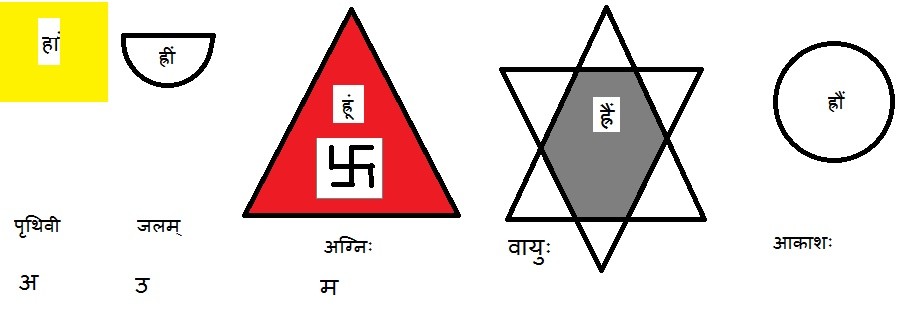The five elements-Panch Mahabhoota
'यथा ब्रह्माण्डे तथा पिण्डें'
All that exists in the universe exists within the body.
Yogic practice helps in bhoota(Element) shuddhi(purification) and siddhi(power of transgression) to help overcoming the material elements and merge with the universal elements to arrive at the knowledge of oneness of the body with the universal nature.
Pancha Mahabhoota theory states that everything in the physical creation is composed of the five elements of Space/Ether, Air, Fire, Water and Earth. All creation emerges from various permutations and combinations of these five elements. In Ayurveda, it is said that components & functioning of the individual nature is similar to our body components and its functions.
The very first element that comes to existence is akash (Ether). The next element derived is Vayu (Air) then comes Agni (Fire), then Jala (water) element is formed and lastly Prithvi (earth) element is formed.
Space-Akash/Ether: It is most expansive and least concrete of all. Ether element is all pervasive and motionless. It corelates to the tanmatra(subtle element) of Shabda(sound) and the sensory organ is the ears. Yogic physiology/ psychic location at Vishuddhi Chakra. Physical location at top of the head. Esoteric representation: circular black void. This element is harnessed through meditation.
Air- Vayu: Air element is to do with any kind of kinetic movement. It's tanmatra( subtle element) is the sense of touch-Sparsh. The sensory organ related to Air element is skin-twacha. Yogic physiology/ psychic location at the Anahat chakra. Physical location between the heart to the eyebrows. Esoteric representation: blue gray hexagonal star. This element is harnessed by pranayama and yogic breathing practice. Tip: while writing articles or literary pursuits, Vayu is the element to use for best results.
Fire-Agni: All forms of transformation including digestion of food are carried out by fire element. The tanmatra of fire element is the sense of sight(Roopa)and gives perception of light . The sensory organ related to Agni is the eyes-chakshu. Yogic physiology/ psychic location at Manipur Chakra. Physical location between the heart and navel. Esoteric representation: red triangle. This element is harnessed through yoga Asana practice.
Water-Jala/ Apa: The sense of taste/rasa is the tanmatra of water element. The sensory organ related to Jala element is the tongue/jihwa. Physical location between the navel and knees. Yogic physiology/ psychic location at Swadhishthan Chakra. Esoteric representation: white crescent moon. This element is harnessed by the practice of Ushapan- drinking water first thing in the morning and by bathing in water.
Earth- Prithvi: The Earth element is responsible for giving structure, shape and strength to the body. The tanmatra of Prithvi tattva is Gandha, smell so the sensory organ related to it is the nose. Physical location between toes and the knees. Yogic physiology/ psychic location at Mooladhara Chakra. Esoteric representation: yellow square. This element is harnessed by mud baths or walking barefoot on earth- grounding.
Followers of Vedic lifestyle typically begin the day with an invocation to Mother Earth while stepping out of bed. It is a praise to her bounteous beauty and offering apology for putting our feet on her whilst seeking permission to do so.
From the health perspective, it is recommended to keep all the elements in their respective balance within the body to gain abundant health. Eating as per the location and seasons is important to this.
Mudras are hand gestures that help in creating corresponding energy flow by manipulation of the representative elements within the fingers. These gestures are used in higher yogic practice and also effectively applied in yogic therapy. The fingers that correspond to the elements: Thumb= Agni/Fire; Index= Air/Vayu; Middle = Space/Akash;Ring= Prithvi/ Earth and the Little finger = Jala/ Water.
"We are developing the idea that our consciousness is part of the material world and that with our consciousness we can directly influence our world," said Dr. Konstantin Korotkov.
https://youtu.be/B6NIUV24vcQ
This is a classic example of the theory of Samkhya philosophy, which corelates evolution from the five gross and five subtle elements; the five sense organs and the five organs of action; the finer elements of mind, intellect and ego; using the subliminal gunas(quality) of Sattva(purity), Rajas(active)and Tamas(inert): to the final unification where Prakriti(manifest nature) merges into the cosmic consciousness(Purusha).
AHAM BRAHMASMI : अहं ब्रह्म अस्मि - Brihadaranyaka Upanishad
I am that/ That I am: the universe which is within me is one of the four Maha-vavkya(great words) of Vedanta and is used to explain the unity of macrocosm and microcosm.
Thus Vedanta advocates study of that I, the self to understand the universe and universal way of which we are one and the same.
"महाभूतानि पंचैव सर्वभूतेषु भूतकृत।
अकरोत् तेषु वैषम्यं तनु जीवो न पश्यति।।"
– महाभारत – 12/194/8
"महाभूतानि पंचैव सर्वभू तेषु भूतकृत्।
अकरोत् तात वैषम्यं यस्मिन् यदनुपश्यति।।"
– महाभारत 12/247/6



